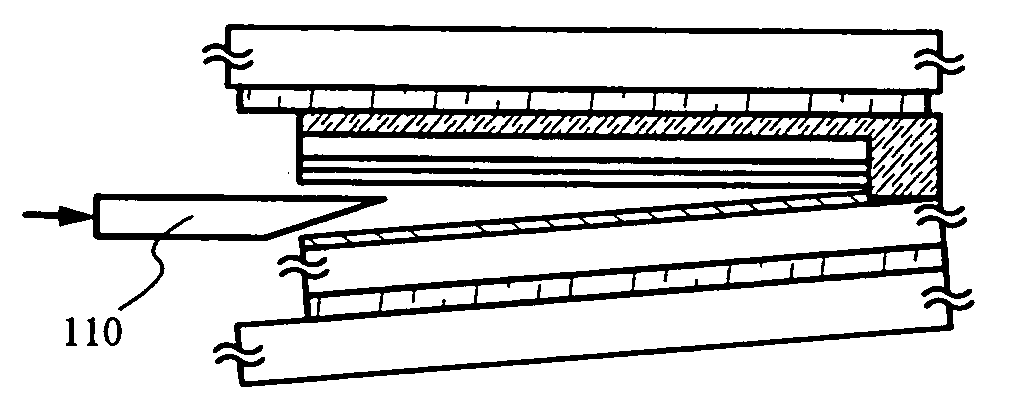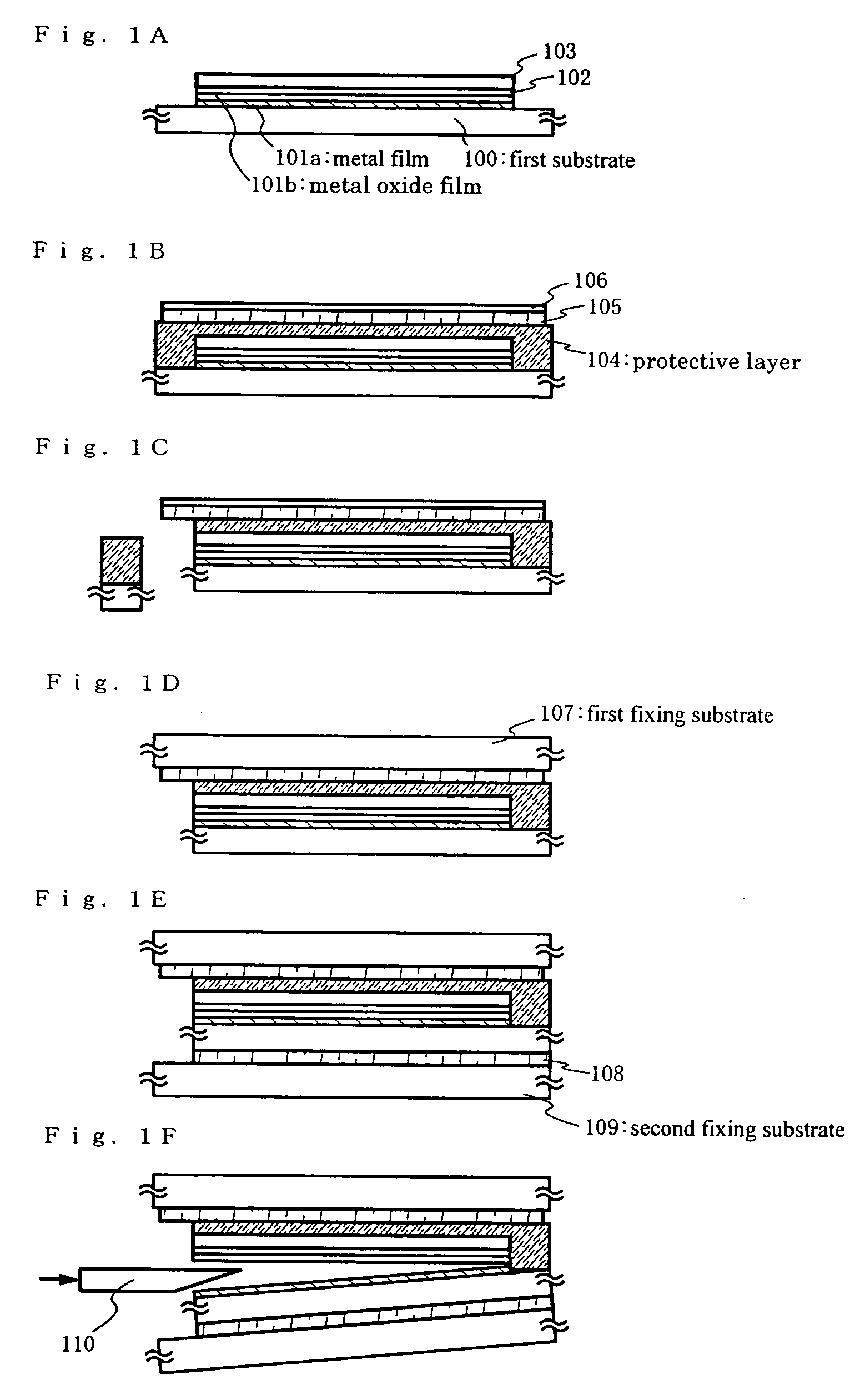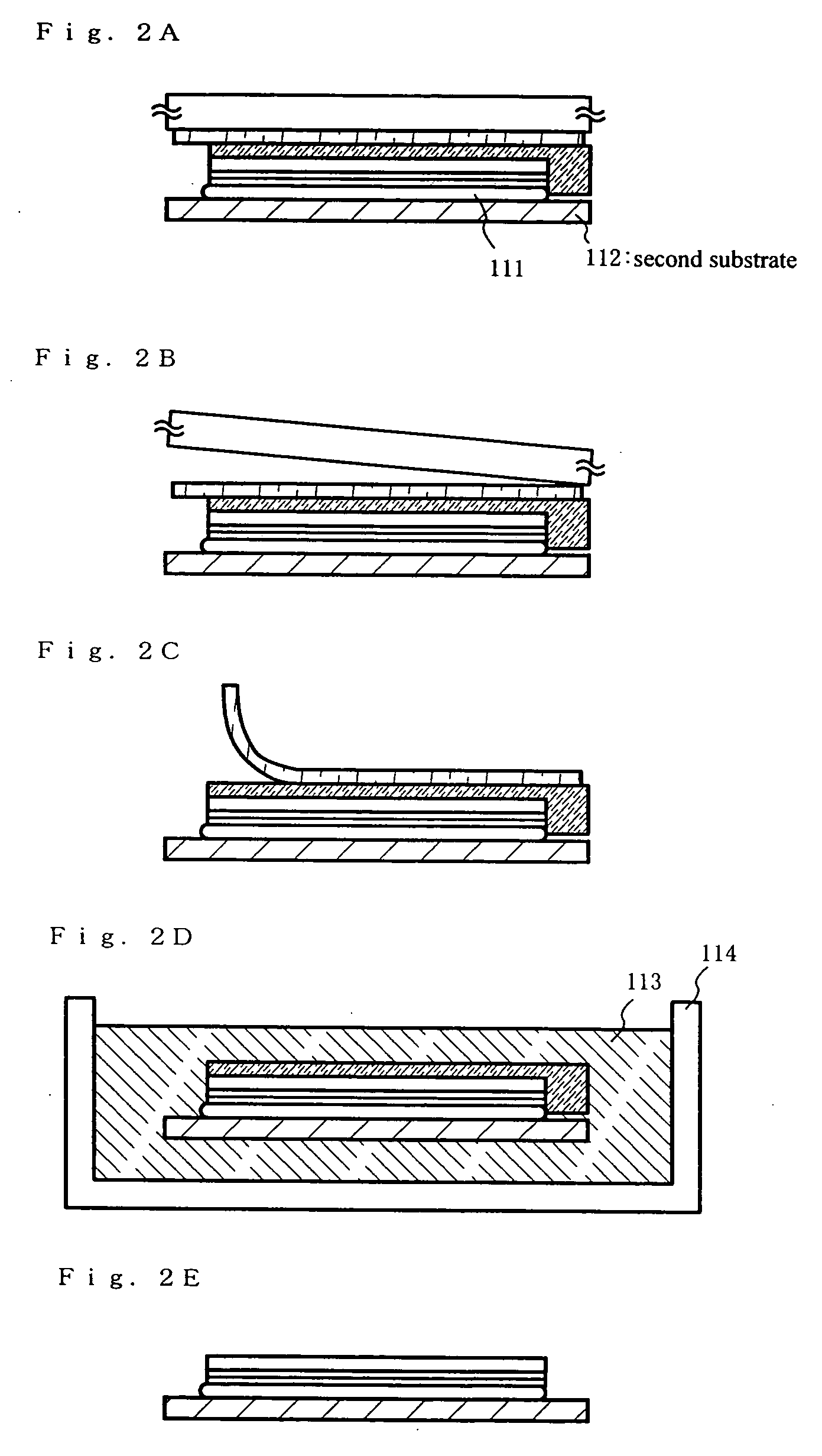Method for manufacturing semiconductor device
a manufacturing method and semiconductor technology, applied in the field of semiconductor devices, can solve the problems of difficult to reduce the highest temperature of a process, difficult to make glass substrates and quartz substrates larger, and easy cracking and heavy, and achieve the effect of preferable yield
- Summary
- Abstract
- Description
- Claims
- Application Information
AI Technical Summary
Benefits of technology
Problems solved by technology
Method used
Image
Examples
embodiment mode 1
[0056] Here, a method for peeling with the use of a metal film and a silicon oxide film is used.
[0057] Initially, a peeling layer 103 which includes a semiconductor integrated circuit (here, a CPU), a terminal electrode (not shown), and an alignment marker (not shown) is formed over a first substrate 100.
[0058] A metal film 101a, here, a tungsten film (a film thickness of from 10 nm to 200 nm, preferably from 30 nm to 75 nm) is formed by sputtering, and an oxide film 102, here, a silicon oxide film (a film thickness of from 150 nm to 200 nm) is further laminated over the substrate without being exposed to the atmospheric air by sputtering. The film thickness of the oxide film 102 is desirably twice that of the metal film. At the time of laminating, a metal oxide film (a tungsten oxide film) in an amorphous state is formed with a thickness of from 2 nm to 5 nm between the metal film 101a and the silicon oxide film 102. In peeling in a later step, separation occurs inside the tungst...
embodiment mode 2
[0092] Here, when an FPC is pressure-bonded to a device which is transferred to a flexible substrate such as a plastic film, a method for preventing a defect such as a crack and the like is shown with reference to FIGS. 4A to 4C.
[0093] Initially, a peeling layer formed over a glass substrate is transferred to a flexible substrate according to Embodiment Mode 1. After forming a metal film over the glass substrate, at the time of forming an oxide film 404, a metal oxide film in an amorphous state is formed between the metal film and the oxide film. The peeling layer is then formed over the oxide film 404.
[0094] As the peeling layer to be transferred, a layer 405a including a circuit having an element 405a, and a terminal electrode 405b are formed, and a protective layer 405c formed from a resin to prevent a crack is formed thereover.
[0095] The metal oxide film becomes a crystallized metal oxide film 403 by performing heat treatment of 400° C. or more in a process to form the peelin...
embodiment 1
[0102] In this embodiment, an example of transferring a semiconductor integrated circuit, typically, a CPU to a plastic substrate is shown. FIG. 5A shows a cross-sectional view before transferring, and FIG. 5B shows a cross-sectional view after transferring.
[0103] Initially, a metal layer 21 is formed over a thermostability substrate 20 such as a quartz substrate or a glass substrate. In this embodiment, Corning 1737 (or EAGLE 2000) of 5 inches manufactured by Corning Incorporated is used as a glass substrate.
[0104] As a material forming the metal layer 21, an element of tungsten (W), molybdenum (Mo), technetium (Tc), rhenium (Re), ruthenium (Ru), osmium (Os), rhodium (Rh), iridium (Ir), palladium (Pd), and silver (Ag), an alloy containing the element as its main component, or a monolayer or lamination layer of nitride (for example, titanium nitride, tungsten nitride, tantalum nitride, or molybdenum nitride) can be used.
[0105] In this embodiment, the metal film 21, here, a tungst...
PUM
 Login to View More
Login to View More Abstract
Description
Claims
Application Information
 Login to View More
Login to View More - R&D
- Intellectual Property
- Life Sciences
- Materials
- Tech Scout
- Unparalleled Data Quality
- Higher Quality Content
- 60% Fewer Hallucinations
Browse by: Latest US Patents, China's latest patents, Technical Efficacy Thesaurus, Application Domain, Technology Topic, Popular Technical Reports.
© 2025 PatSnap. All rights reserved.Legal|Privacy policy|Modern Slavery Act Transparency Statement|Sitemap|About US| Contact US: help@patsnap.com



